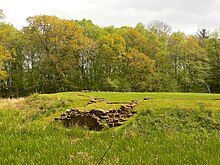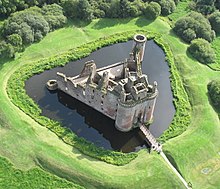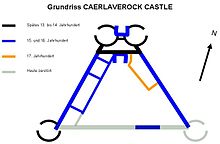Caerlaverock Castle
| Caerlaverock Castle | |
|---|---|
|
The moated Caerlaverock Castle, general view from the front |
|
| Creation time : | around 1270 |
| Castle type : | Niederungsburg |
| Conservation status: | ruin |
| Place: | Dumfries |
| Geographical location | 54 ° 58 ′ 30 ″ N , 3 ° 31 ′ 26 ″ W |
Caerlaverock Castle is a well-preserved castle ruins in the region of Dumfries and Galloway in Scotland . It is located about eight miles southeast of Dumfries on the B725.
The foundation stone for the castle was laid around 1270. It is the only triangular moated castle in Scotland. On the northern corner is the gatehouse , which consists of a double tower. The castle is completely surrounded by a moat filled with water and was not, like many other castles, built on a rock.
Construction phases
Caerlaverock First Castle
The original castle, called Caerlaverock First Castle , was built about 200 m south of the current castle. In 1220, Sir John Maxwell ordered the construction of this predecessor, which was to guard the "Gateway to Scotland". The first castle stood in a tide-dependent swamp area, which at that time had a much higher water level than it does today and which ended in a harbor-like bay. The castle did not stand alone, but was surrounded by a large fence / enclosure.
The main task of the castle builders at the time was to create an almost square platform on the clayey subsoil. A bridge was built north of the moat . A residential building was built on the south side, to which the outer castle wall was finally connected. The two opposite main buildings were connected by a protected wall passage so that prepared food could be brought from the kitchen building to the main house protected from rain. Some time later, towers were erected at the corners of the outer wall, which together with the main buildings covered all four corners of the castle.
The First Castle finally sank into the unstable and swampy subsoil, which was simply too damp for the castle to be built and which led to the building and its walls collapsing. Less than 50 years after it was built, the building had to be abandoned because repairs did not seem to make sense. According to the latest findings, the completion of the second watchtower was probably never completed.
Excavations in 1978 showed that First Castle was one of the oldest stone castles in Scotland. Today, however, only ground-level rudiments of the foundation walls of the First Castle can be seen , which give little information about the former splendor of these buildings.
Caerlaverock New Castle
The Maxwells decided in 1270 to build a new castle about 200 m further north: the Caerlaverock New Castle , as it can be seen today. Completion is estimated at 1277 based on wood finds that have been subjected to an age study.
Caerlaverock's new castle has had various renovations over the years. In 1290, many parts of the building still had thatched roofs, which over time were replaced by more durable materials such as stone roofs. The individual styles of the epochs can also be found in certain parts of the building, especially in the outer facade of the Nithsdale Lodging , the main building in the castle, which was completed in 1634 and which is described as one of the most elaborate and beautiful castle buildings of its time.
Strategic location
With its imposing walls, the castle is the epitome of medieval strength. The only entrance could be guarded from the twin towers of the gatehouse. Archers and catapults found space on the mighty defensive towers . Generous ramparts were built around the water, which the attackers first had to overcome on foot. But they could be targeted and fought very well by the archers.
The only disadvantage the defenders of the castle suffered was that the castle could not be left in the event of an attack or siege . Similarly strategically well-located castles such as Girnigoe and Sinclair Castle had at least secret passages that enabled the defenders to either flee or to procure new food in the event of a siege in the event of food shortages. This was not possible at Caerlaverock Castle.
Due to its proximity to the English border, the castle played an important role in the border conflicts of that time. In the Middle Ages it served to protect trade and traffic routes over the Nith and Solway rivers . Sir John Maxwell was thus the guardian of the so-called West March .
history
Caerlaverock Castle was the seat of Maxwell - Clans . During the First Scottish War of Independence , the Scottish occupation of Caerlaverock Castle repeatedly attacked the English occupation of the nearby Lochmaben Castle . During one of these skirmishes, Robert Cunningham , the commandant of Caerlaverock Castle, was killed. Robert Felton , the commanding officer of Lochmaben, had the severed head of Cunningham attached to the top of the main tower of Lochmaben. During his campaign in the summer of 1300, the English King Edward I besieged Caerlaverock Castle from July 10th. The crew wanted to hand over the castle under honorable conditions, but the king had the castle bombarded with siege engines so that the castle could be captured after two days. How the crew of about sixty was treated is unclear. According to one chronicler, their lives were spared; according to other sources, twenty-two were taken to English prisons while the others were hanged. An unknown poet, who presumably witnessed it as a herald on the English side, wrote the Song of Caerlaverock about the siege . Caerlaverock was then held by an English garrison. In July 1312, the Scottish King Robert I personally took over the management of a siege by the Scots, whereupon the castle was probably recaptured a little later.
The castle was attacked or captured by the English several times (1544 and 1570) until the unification of the Scottish and English crowns in 1603 brought an end to the armed conflict between the two kingdoms.
During the civil war , the Maxwell clan, which was on the side of King Charles I , had to defend itself against a siege army of the Presbyterian Covenanters as early as 1640 . The besiegers were unable to take the castle, but when food ran out after 13 weeks, the defenders finally had to give up.
The castle today
The last attackers used siege weapons of their time, presumably cannons , and left the castle in a partially destroyed state. As a result, the owners changed from the Herries family to the Duke of Norfolk , who placed them under state supervision in 1946. After extensive maintenance work, the complex is now under the care of Historic Scotland . Replicas of the catapults known as Warwulf are exhibited around the castle . During the siege of 1300, the stones thrown by these catapults not only destroyed the ring walls, but the resulting fragments forced the crew to leave their places on the walls, whereupon the English were able to storm the castle.
Video of Caerlaverock Castle, part 1
Video of Caerlaverock Castle, part 2
Video of Caerlaverock Castle, part 3
Trivia
Caerlaverock Castle was used in the film Who is the Bride? as the backdrop for Hegg Castle , which is being temporarily moved from a ruin to a habitable state for a wedding.
Individual evidence
- ^ Grove, 1994 , p. 18
- ^ Grove, 1994 , p. 10
- ^ Geoffrey WS Barrow: Robert Bruce and the Community of the Realm of Scotland . Eyre & Spottiswoode, London 1965, pp. 158-159.
- ↑ Michael Prestwich: Edward I . Berkeley, University of California Press, 1988, ISBN 0-520-06266-3 , p. 487.
- ^ Geoffrey WS Barrow: Robert Bruce and the Community of the Realm of Scotland . Eyre & Spottiswoode, London 1965, p. 276.
- ↑ Grove, 1994 , pp. 25f.
- ↑ Grove, 1994 , p. 27
literature
- Coventry, Martin: The Castles of Scotland (4th Edition) . Polygon, Goblinshead, 2006.
- Grove, Doreen: Caerlaverock Castle . Historic Scotland, Edinburgh 1994, reprinted 1997. ISBN 0748008519 .
Web links
- Official site at Historic Scotland (English)
- Caerlaverock.org (English)
- Caerlaverock at Burgen.de









